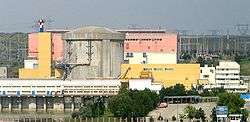Cernavodă Nuclear Power Plant
| Cernavodă Nuclear Power Plant | |
|---|---|
 The Cernavodă Nuclear Power Plant | |
 Location of Cernavodă Nuclear Power Plant in Romania | |
| Country | Romania |
| Coordinates | 44°19′20″N 28°03′26″E / 44.32222°N 28.05722°ECoordinates: 44°19′20″N 28°03′26″E / 44.32222°N 28.05722°E |
| Construction began | 1980s |
| Commission date | 2 December 1996 |
| Operator(s) | Nuclearelectrica |
| Nuclear power station | |
| Reactor type | PHWR |
| Reactor supplier | CANDU |
| Power generation | |
| Units operational | 2 x 700 MW |
| Units planned | 2 x 750 MW |
| Average generation | 11,618 GW·h[1] |


The Nuclear Power Plant in Cernavodă (Romanian: Centrala Nucleară de la Cernavodă) is a nuclear power plant in Romania. It produces around 20% of the country's electricity. It uses CANDU reactor technology from AECL, using heavy water produced at Drobeta-Turnu Severin as its neutron moderator and water from the Danube – Black Sea Canal for cooling.
By using nuclear power, Romania is able to reduce its greenhouse gas emissions by over 10 million tonnes each year.
The power plant was designed in Canada by Atomic Energy of Canada Limited in the 1980s, and was contracted during the Communist era. The initial plan was to build five units. Units 1 and 2 are currently operational. Three more partially completed CANDU reactors exist on the same site, part of a project discontinued at the fall of Ceauşescu regime.
CNE-INVEST is responsible for the preservation of Units 3-5.
Reactors
Unit 1
Unit 1, a CANDU 6-type, was finished in 1996 and produces 705.6 MW of electricity.
It was commissioned and began operating at full power in 1996 and has had record capacity factors of 90 per cent since 2005.
Unit 2
A consortium of AECL and Ansaldo Nucleare of Italy, along with the Nuclearelectrica (SNN) SA, Romania’s nuclear public utility, was contracted in 2003 to manage the construction of the partially completed Unit 2 power plant and to commission it into service.
Four years later, Unit 2, another CANDU 6-reactor, achieved criticality on 6 May 2007[2] and was connected to the national grid on 7 August. It began operating at full capacity on 12 September 2007,[3] also producing 706MW.
Unit 2 was officially commissioned on Friday, October 5, 2007 during ceremonies attended by Romanian Prime Minister Călin Popescu-Tăriceanu and senior officials from Atomic Energy of Canada Limited (AECL).[4] This makes CNE-Cernavoda Station the third largest power producer in the country.
Future expansion
Units 3 and 4
Units 3 and 4 were expected to be CANDU 6 reactors with a similar design to Unit 2 and will each have a capacity of 720 MW.[5] The project was estimated to take up to six years after the contracts are signed.
In a feasibility study carried out by Deloitte and Touche, the most economically viable scenario would be to build the two phases at the same time, with the cost estimated at €2.3 billion.
On 20 November 2008, Nuclearelectrica, ArcelorMittal, ČEZ, GDF Suez, Enel, Iberdrola and RWE agreed to set up a joint company dedicated to the completion, commissioning and operation of Units 3 and 4. The company named Energonuclear was registered in March 2009.[6]
20 January 2011, GDF Suez, Iberdrola and RWE pulled out of the project, following ČEZ which had already left in 2010, citing "Economic and market-related uncertainties surrounding this project, related for the most part to the present financial crisis, are not reconcilable now with the capital requirements of a new nuclear power project".[7] That left Nuclearelectrica with large majority share in the project, prompting a search for other investors. In November 2013, China General Nuclear Power Corp. (CGN) signed an agreement to invest in the project at an undisclosed level. Shortly thereafter, AcelorMittal and Enel announced plans to sell their stakes.[8]
In 2016 the Romanian government gave support for the creation of a joint venture led by CGN to progress the project.[9]
Unit 5
There are currently no plans to complete Unit 5 at this time. However, the possibility of finishing construction remains.
Incidents
- On 30 May 2009, Unit 1 of the Romania's Cernavoda NPP was shut down following a water pipe crack. The Cernavoda NPP's second unit was undergoing an overhaul, so it was not producing any electricity.[10]
- On 8 Apr 2009, the second reactor of the Romania's Cernavoda NPP was shut down due to a malfunction which led to electrical outages.[11]
- On 16 January 2010, the first unit was shut down due to steam leakage.[12]
See also
References
- ↑ http://www.iea.org/statistics/statisticssearch/report/year=2013&country=ROMANIA&product=ElectricityandHeat
- ↑ Cernavoda 2 achieves initial criticality Archived September 30, 2007, at the Wayback Machine.
- ↑ Hotnews.ro, Reactorul 2 de la Cernavoda a ajuns la capacitate maxima ("The second unit at the Cernavodă Nuclear Power Plant reached at full capacity "), September 12, 2007
- ↑ 2007 News Releases - Second CANDU Unit in European Union Officially In Service Archived November 17, 2007, at the Wayback Machine.
- ↑ www.adevarul.ro 12 February 2010
- ↑ "Draft agreement finalized for Romanian reactors". World Nuclear News. 2008-03-07. Retrieved 2008-03-07.
- ↑ rwe.com 20 January 2011: GDF SUEZ, RWE and Iberdrola have decided not to continue to participate in the Cernavoda nuclear project in Romania
- ↑ "UPDATE 2-RWE, Iberdrola, GDF Suez exit Romania nuclear plan". Reuters. 20 January 2011.
- ↑ "Romania expresses support for China's role at Cernavoda". World Nuclear News. 25 January 2016. Retrieved 27 January 2016.
- ↑ Romania’s Nuclearelectrica Shuts Down Nuke Over Water Pipe Crack, Mediafax 2009-05-30
- ↑ Romania's Cernavoda Nuclear Plant Restarts 2nd Reactor, Mediafax, 2009-04-09
- ↑ "Archived copy". Archived from the original on 2010-01-18. Retrieved 2010-01-17.